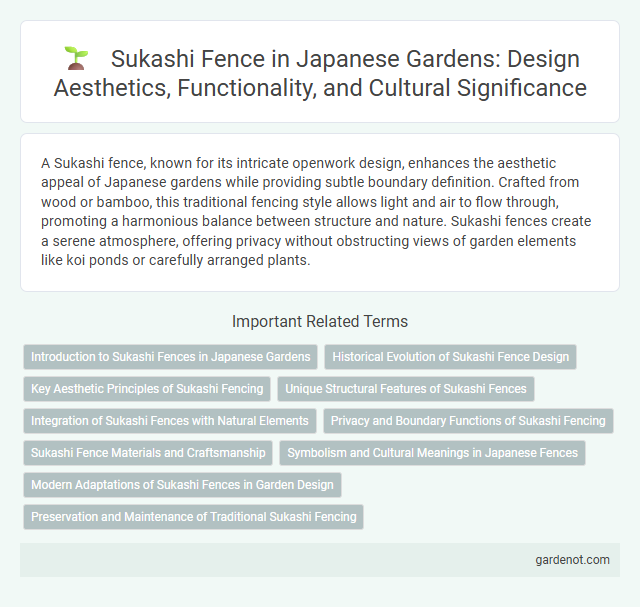A Sukashi fence, known for its intricate openwork design, enhances the aesthetic appeal of Japanese gardens while providing subtle boundary definition. Crafted from wood or bamboo, this traditional fencing style allows light and air to flow through, promoting a harmonious balance between structure and nature. Sukashi fences create a serene atmosphere, offering privacy without obstructing views of garden elements like koi ponds or carefully arranged plants.
Introduction to Sukashi Fences in Japanese Gardens
Sukashi fences are intricately designed wooden structures featuring openwork patterns that allow light and air to pass through while providing subtle separation within Japanese gardens. These fences blend functionality with aesthetic elegance, often showcasing traditional motifs such as geometric shapes or natural elements like bamboo and pine. Their delicate craftsmanship enhances the garden's harmony, creating a tranquil atmosphere that respects the principles of wabi-sabi and asymmetry.
Historical Evolution of Sukashi Fence Design
The Sukashi fence, originating in the Edo period of Japan, evolved from simple wooden barriers to intricate, openwork designs showcasing skilled craftsmanship. This traditional fencing style uses latticed patterns to symbolize harmony between nature and human presence, reflecting Zen Buddhist aesthetics. Over centuries, Sukashi fences have incorporated diverse motifs inspired by local flora and cultural symbolism, marking their historical development as both functional and artful garden elements.
Key Aesthetic Principles of Sukashi Fencing
Sukashi fencing embodies the Japanese aesthetic principle of ma, emphasizing the importance of negative space to create harmony and balance within garden design. Crafted with intricate cut-out patterns, these fences allow filtered views and light, enhancing the connection between the garden's natural elements and architectural structure. The delicate interplay of shadow and openness in Sukashi fencing reflects the Zen influence on Japanese gardens, promoting tranquility and mindfulness.
Unique Structural Features of Sukashi Fences
Sukashi fences are characterized by their intricate openwork design, often featuring geometric or natural motifs carved into thin wooden or bamboo slats. These fences balance privacy and transparency, allowing partial views of the garden while maintaining a delicate, airy aesthetic. The craftsmanship emphasizes natural materials and traditional joinery techniques, reflecting the harmony between structural function and artistic expression in Japanese garden design.
Integration of Sukashi Fences with Natural Elements
Sukashi fences in Japanese gardens harmonize seamlessly with natural surroundings through their openwork design, which mimics the delicate patterns of tree branches and leaves. Crafted from materials like bamboo or wood, these fences allow light and air to flow freely, creating a sense of unity between the garden and the fence. Their intricate patterns enhance the garden's aesthetic by framing views of plants, rocks, and water features without obstructing the natural scenery.
Privacy and Boundary Functions of Sukashi Fencing
Sukashi fencing in Japanese gardens serves as an elegant boundary marker, seamlessly blending privacy with natural aesthetics through its openwork design. The lattice structure allows filtered light and air flow while creating a subtle visual barrier that defines garden spaces without harsh obstruction. This balance of transparency and enclosure plays a crucial role in maintaining intimate privacy and delineating distinct garden areas.
Sukashi Fence Materials and Craftsmanship
Sukashi fence in Japanese gardens is traditionally crafted from high-quality bamboo or cypress wood, emphasizing natural textures and durability. Artisans meticulously carve intricate openwork patterns to balance privacy with aesthetic lightness, showcasing expert craftsmanship passed down through generations. The combination of sustainable materials and precise joinery techniques ensures both structural integrity and harmonious integration with the garden's serene environment.
Symbolism and Cultural Meanings in Japanese Fences
The Sukashi fence, characterized by its open latticework and intricate cutouts, embodies the Japanese aesthetic principle of "ma," emphasizing space and balance between solidity and void. Symbolically, it represents transparency and harmony with nature, allowing light and air to flow freely while providing subtle enclosure. This type of fence reflects cultural values of simplicity, mindfulness, and the seamless integration of human-made structures with the surrounding garden landscape.
Modern Adaptations of Sukashi Fences in Garden Design
Modern adaptations of Sukashi fences integrate traditional openwork bamboo patterns with contemporary materials such as metal and resin, enhancing durability while preserving aesthetic appeal. Designers incorporate these fences to create visually light partitions that maintain airflow and natural light, complementing minimalist garden layouts. This fusion of classic craftsmanship with innovative elements reflects a growing trend in sustainable, functional garden architecture.
Preservation and Maintenance of Traditional Sukashi Fencing
Preservation and maintenance of traditional Sukashi fencing involve using natural materials such as bamboo and cedar, which require regular inspection and replacement to prevent decay and insect damage. Skilled craftsmanship in weaving and fastening ensures the fence retains its delicate lattice pattern, integral to the garden's aesthetic harmony. Applying natural preservatives and controlling moisture levels extend the lifespan of Sukashi fencing while maintaining its cultural authenticity.
Sukashi fence Infographic

 gardenot.com
gardenot.com